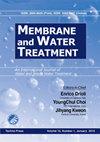金合欢对酸性黑1的去除作用吸附动力学、等温线和热力学研究
IF 1.1
4区 工程技术
Q4 ENGINEERING, CHEMICAL
引用次数: 2
摘要
在室温条件下,研究了酸性黑1 (AB1)等阴离子染料在生物吸附剂金合木上的批量吸附。考察了接触时间、吸附剂用量、染料初始浓度和温度等理化参数对染料去除率的影响。采用拟一阶和拟二阶动力学模型研究了AB1染料的线性和非线性吸附动力学,但拟二阶模型与生物吸附剂刺槐吸附AB1染料的实验数据吻合较好,回归系数最大值为0.9995。采用Langmuir、Freundlich、Tempkin和Dubinin - Radushkevich (D-R)的线性和非线性形式来揭示实验数据,但吸附AB1染料的实验数据很好地符合Langmuir等温线模型,吸附容量为3.21✕10-4。吸附热力学研究表明,AB1染料在吸附剂合欢树上的吸附是吸热自发的过程。研究表明,金合欢是一种去除水中染料的良好生物吸附剂。本文章由计算机程序翻译,如有差异,请以英文原文为准。
Removal of acid black 1 by Acacia Concinna; adsorption kinetics, isotherm and thermodynamic study
In the present research, batch adsorption of anionic dye such as Acid Black 1 (AB1) in aqueous solution onto biosorbent Acacia concinna was investigated at room temperature. The effect of various physico-chemical parameters such as contact time, adsorbent dosage, initial dye concentration and temperature on the percentage removal of dye were investigated. Adsorption kinetics was investigated using linear and nonlinear form of pseudo first-order and pseudo-second-order kinetic models but experimental data for adsorption of AB1 dye in aqueous mixture onto biosorbent Acacia concinna was fitted well to pseudo-second order model with maximum value of regression coefficient (0.9995). Linear and nonlinear forms of Langmuir, Freundlich, Tempkin, and Dubinin– Radushkevich (D–R) were used to reveal experimental data but experimental data for adsorption of AB1 dye in aqueous mixture onto biosorbent Acacia concinna fitted well to the Langmuir isotherm model with adsorption capacity 3.21✕10-4 Adsorption thermodynamic study showed that adsorption of AB1 dye onto adsorbent Acacia concinna was endothermic and spontaneous process. This study revealed that biosorbent Acacia concinna was good biosorbent for removal of dyes from aqueous solution.
求助全文
通过发布文献求助,成功后即可免费获取论文全文。
去求助
来源期刊

Membrane Water Treatment
ENGINEERING, CHEMICAL-WATER RESOURCES
CiteScore
1.90
自引率
30.00%
发文量
0
审稿时长
>12 weeks
期刊介绍:
The Membrane and Water Treatment(MWT), An International Journal, aims at opening an access to the valuable source of technical information and providing an excellent publication channel for the global community of researchers in Membrane and Water Treatment related area. Specific emphasis of the journal may include but not limited to; the engineering and scientific aspects of understanding the basic mechanisms and applying membranes for water and waste water treatment, such as transport phenomena, surface characteristics, fouling, scaling, desalination, membrane bioreactors, water reuse, and system optimization.
 求助内容:
求助内容: 应助结果提醒方式:
应助结果提醒方式:


